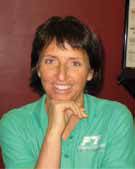Golf and Rotation

by Paula Allia PT, DHSc, MTC, OCS
by Paula Allia
There are many sports that people participate in that torque the body. Torque is a force that causes rotation or torsion and in golf this occurs with every swing.
Golf incorporates a combination of movements from your toes all the way up the chain to your head. The combination of trunk and pelvis rotation with the hips distally and the shoulders proximally make all of the difference in fluid movement.
Do you have the right range of motion in your joints to coordinate the proper movement pattern resulting in a good swing? Do you have the proper amount of flexibility in the muscles and other connective tissue to work with the joint’s range of motion? So many variables. It is no wonder most people’s golf swing is not consistent.
Learning to rotate the spine in combination with your appendages is a major component to having success. Having both the flexibility in the muscles and the mobility in the joints is what allows one to approach the proper mechanics of a golf swing. Also important is the coordinated efforts of proper muscle recruitment timing and coordination. Many middle age adults and older have movement impairments that actually inhibit the perfect golf swing. How does one swing as properly as possible? This is something that most people try and attain every time they step foot on the course or practice facilities. Learning how to compensate for imbalances will help the golf game tremendously.
Many golfers experience low back or hip pain. Chronic low back pain and dysfunction are common in those who play a lot of golf and have disc, facet joint, and or arthritic problems. If muscles are tight and not recruited properly, excessive compressive loads can cause further breakdown and over time become debilitating. Also, a stiff spine in the thoracic area working with the arms will cause altered mechanics.
People pull muscles all of the time in golf. The mobile segments of the spine that are functioning properly are stable. When and if a segment’s quality of motion changes, a segment can become hypomobile. This can be due to a tight joint capsule around the joint(s) of that spinal segment (facet joints). If a joint does become restricted, movement in another vertebral segment may actually loosen and become hypermobile to make up for the restrictions in the tight joint. Both can become problematic and can lead to disc and arthritic changes with continued overuse of the hypermobile segment or underuse of the hypomobile joint.
Smooth segmental recruitment from vertebra to vertebra allows the spine to rotate without excessive torque on one level. The interesting dynamic is that if someone has a hypomobile segment where the disc and the vertebra are restricted, the next mobile segment takes on more torque.
A hypermobile segment is a segment that has more laxity in the joint capsule and or ligaments. When someone pops their own back, the segment that moves is likely the hypermobile joint, not the one that is actually restricted. Since the back is weightbearing and loaded most of the time just with body weight and gravity, this can cause wear and tear and arthritic conditions as well and wear down and thin the discs.
If someone has arthritis evident in an x-ray, where the ligaments or muscles pull on the joint bone spurring can result adding more issues. It is now evident that in order to be able to participate in golf and not cause further breakdown having the necessary flexibility and mechanics is most beneficial. A properly executed backswing will help allow the club to do the work improving the club speed. Do not try and muscle the swing as this leads to more strain. If you are limited, do not just start taking anti-inflammatories and painkillers because the body will worsen. Find out where your restrictions are and how to adapt to your limitations.
To Your Health!




Leave a Reply
Want to join the discussion?Feel free to contribute!